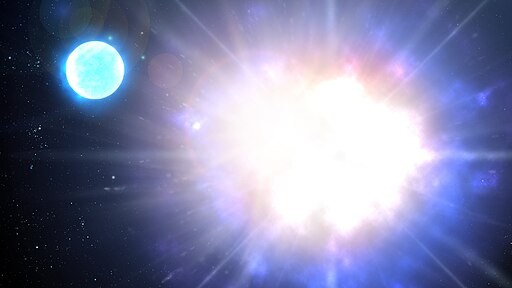The Sun and other stars are composed almost entirely of hydrogen and helium, the two lightest elements in the universe. Other elements like gold, iron, oxygen, and carbon were formed in astrophysical processes like colliding neutron stars, supernovae, and stellar fusion.
Extreme Helium Stars
Throughout the universe, supergiant stars are much larger and hotter than our Sun, although they are less massive. Known as extreme helium stars (EHe), these stellar objects are almost devoid of hydrogen, which is unusual since hydrogen is the most abundant chemical element in the cosmos.
Extreme helium stars are characterized by relatively sharp and strong lines of neutral helium, which indicate low surface gravities and atmospheres dominated by helium. In addition to helium, these stars also contain significant amounts of oxygen, nitrogen, and carbon.
The first known EHe star, HD 124448, was discovered in 1942 by Daniel M. Popper at the McDonald Observatory near Fort Davis, Texas. Together with V1920 Cyg, HD 124448 provides the first measurements of abundances of neutron-capture elements for extreme helium stars.
READ ALSO: Red Supergiant Star Transforms Into Type II Supernova as Scientists Watch Real Time
Metal-Poor EHe
Just recently, astronomers discovered an extremely helium star in the Galactic halo located at a distance of about 15,500 light years. Known as EC 19529-4430, this stellar body has an effective temperature of 18,540 K with a surface that appears to be composed mainly of carbon-nitrogen-oxygen (CNO)-processed helium.
EC 19529-4430 was identified as a helium-rich star in the Edinburgh-Cape Survey of faint-blue objects. It was also subsequently resolved as an EHe in chemically peculiar hot subdwarfs.
A team of scientists has decided to explore the characteristics of EC 19529-4430 further to gain more information about its true nature. Led by Simon Jeffery of the Armagh Observatory and Planetarium in Armagh, UK, the team used the Southern African Large Telescope (SALT) 's High-Resolution Spectrograph (HRS) and Robert Stobie Spectrograph (RSS).
SALT observations revealed that EC 19529-4430 has an effective temperature of 20,700 K and an overall metallicity of -1.3 dex. Astronomers found that nitrogen is 1.2 dex overabundant, while carbon and oxygen were measured to be 1.5 and 0.7 dex underabundant, respectively.
The study confirmed that the EC 19529-4430 comprises CNO-processed helium. It has a retrograde orbit, and its location in the Galactic halo is consistent with its low overall metallicity. Furthermore, experts added that no pulsations from this stellar object have been identified.
The results of the observations indicate EC 19529-4430 is the most metal-poor extreme helium star detected to date. Moreover, it turns out that this celestial body is also the most fabulous known carbon-poor and nitrogen-rich EHe star.
The study authors tried to explain the origin of EC 19529-4430 and concluded that it is most likely the result of a merger of two helium white dwarfs. These white dwarfs might have formed as a binary system 11 billion years ago. In the future, it is expected to evolve to become a core helium-burning extreme helium subdwarf.
RELATED ARTICLE: Is Betelgeuse Going Supernova? Red Supergiant Star Continues To Show Unexpected Behavior
Check out more news and information on Stars in Science Times.




![Grown Mice With Hybrid Brains Can Smell Using Rat’s Neurons [Study]](https://1721181113.rsc.cdn77.org/data/thumbs/full/53431/89/56/50/40/grown-mice-with-hybrid-brains-can-smell-using-rat-s-neurons-study.jpeg)










